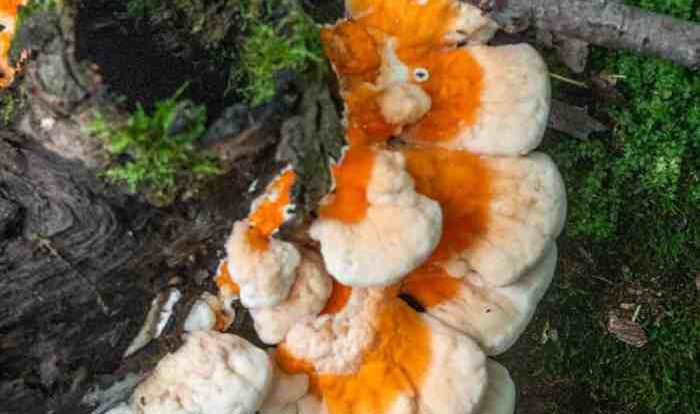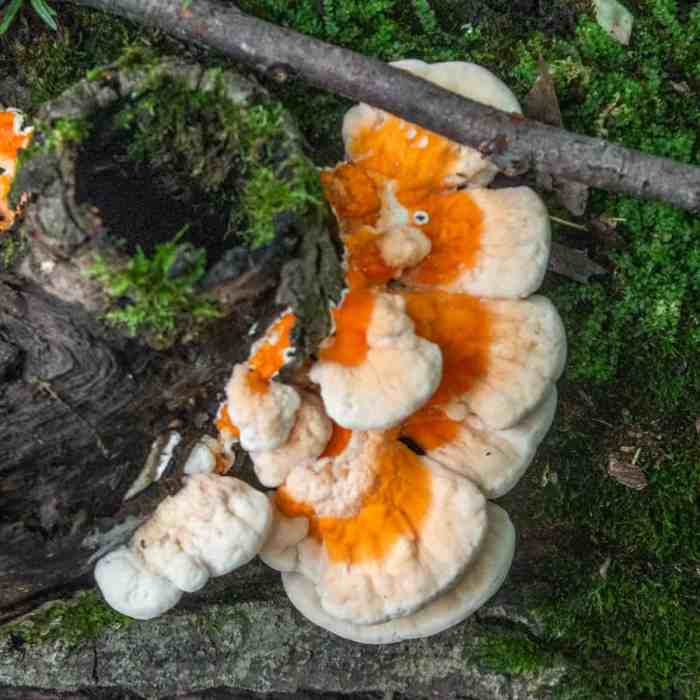
Chicken of the woods recipe – Uncover the secrets of preparing the delectable Chicken of the Woods mushrooms with our comprehensive recipe guide. Embark on a culinary adventure as we explore its nutritional value, cooking techniques, flavor profiles, and ethical harvesting practices.
Recipe Overview

Chicken of the Woods is a delicious and versatile mushroom that can be used in a variety of dishes. It has a meaty texture and a slightly sweet flavor, making it a great substitute for chicken in many recipes.
This recipe will show you how to prepare Chicken of the Woods mushrooms so that you can enjoy them in your favorite dishes.
Ingredients
- 1 pound Chicken of the Woods mushrooms, cleaned and cut into 1-inch pieces
- 1 tablespoon olive oil
- 1/2 teaspoon salt
- 1/4 teaspoon black pepper
Instructions
- Heat the olive oil in a large skillet over medium heat.
- Add the mushrooms to the skillet and cook until they are browned on all sides.
- Season the mushrooms with salt and pepper to taste.
- Serve the mushrooms immediately or use them in your favorite recipes.
Nutritional Value and Health Benefits

Chicken of the Woods mushrooms are not just a tasty treat but also a nutritional powerhouse. They are an excellent source of several essential nutrients, including protein, fiber, vitamins, and minerals.
In terms of protein, Chicken of the Woods mushrooms contain a higher percentage than most vegetables, making them a great option for vegetarians and vegans. They are also a good source of dietary fiber, which is important for maintaining a healthy digestive system and promoting satiety.
Vitamins and Minerals
These mushrooms are also rich in vitamins, including vitamin D, which is crucial for bone health and immune function. Additionally, they are a good source of vitamin C, an antioxidant that helps protect the body from damage caused by free radicals.
Chicken of the woods is a versatile mushroom that can be used in a variety of dishes. If you’re looking for a more adventurous recipe, be sure to check out the chicken of the woods recipe from Mecklenburg County Public Schools.
This recipe uses a combination of spices and herbs to create a flavorful dish that is sure to impress your guests.
Chicken of the Woods mushrooms are also a good source of minerals, such as potassium, which is important for maintaining fluid balance and regulating blood pressure. They also contain iron, which is essential for red blood cell production, and zinc, which plays a role in immune function and cell growth.
Potential Health Benefits
The nutritional content of Chicken of the Woods mushrooms has been linked to several potential health benefits. Studies have shown that these mushrooms may have antioxidant, anti-inflammatory, and antitumor properties.
Additionally, Chicken of the Woods mushrooms have been shown to support immune function and may help protect against certain chronic diseases, such as heart disease and cancer.
Cooking Techniques
Chicken of the Woods mushrooms are versatile culinary delights that can be cooked using various methods. Each technique offers unique advantages and drawbacks, allowing you to tailor the flavor and texture to your preference.
Chicken of the woods is a type of mushroom that has a meaty texture and a delicious flavor. If you’re looking for a new recipe to try, be sure to check out the chicken of the woods recipe from Franklin Elementary School.
This recipe is easy to follow and results in a delicious meal that the whole family will enjoy.
The following section provides an overview of different cooking methods suitable for Chicken of the Woods mushrooms, highlighting their advantages and disadvantages:
Sautéing
Sautéing involves cooking the mushrooms in a pan with a small amount of fat, such as butter or olive oil, over medium heat. This technique is ideal for creating a crispy exterior while maintaining a tender interior.
- Advantages:Quick and easy to prepare, enhances the natural flavors of the mushrooms, and results in a crispy texture.
- Disadvantages:Can be more time-consuming for larger quantities, requires constant stirring to prevent burning, and may not be suitable for all mushroom varieties.
Grilling
Grilling involves cooking the mushrooms directly over an open flame or hot coals. This method imparts a smoky flavor and a slightly charred exterior.
- Advantages:Creates a smoky and flavorful dish, ideal for outdoor cooking, and can be used for both whole mushrooms or sliced.
- Disadvantages:Requires careful monitoring to prevent burning, may not be suitable for all mushroom varieties, and can be challenging to control the temperature.
Roasting
Roasting involves cooking the mushrooms in a preheated oven. This method allows for even cooking and caramelization of the mushrooms, resulting in a tender and flavorful dish.
- Advantages:Easy to prepare, allows for hands-off cooking, and can be used for large quantities of mushrooms.
- Disadvantages:Can be time-consuming, may not be suitable for all mushroom varieties, and requires careful monitoring to prevent overcooking.
Frying
Frying involves submerging the mushrooms in hot oil. This method creates a crispy exterior and a tender interior, resulting in a golden-brown dish.
- Advantages:Quick and easy to prepare, creates a crispy texture, and can be used for both whole mushrooms or sliced.
- Disadvantages:Can be more time-consuming for larger quantities, requires careful monitoring to prevent burning, and may not be suitable for all mushroom varieties.
Stewing
Stewing involves simmering the mushrooms in a liquid, such as broth or wine, over low heat for an extended period. This method results in tender and flavorful mushrooms with a rich sauce.
- Advantages:Creates a tender and flavorful dish, ideal for cold weather cooking, and can be used for both whole mushrooms or sliced.
- Disadvantages:Can be time-consuming, may not be suitable for all mushroom varieties, and requires careful monitoring to prevent overcooking.
Pickling
Pickling involves preserving the mushrooms in a vinegar solution. This method extends the shelf life of the mushrooms and imparts a tangy flavor.
- Advantages:Preserves the mushrooms for extended storage, adds a tangy flavor, and can be used for both whole mushrooms or sliced.
- Disadvantages:Can be time-consuming to prepare, may not be suitable for all mushroom varieties, and requires careful monitoring to prevent spoilage.
Flavor Profiles and Pairing Suggestions: Chicken Of The Woods Recipe

Chicken of the Woods mushrooms are a versatile ingredient that can be used in various dishes. They have a meaty texture and a slightly sweet, nutty flavor. This unique flavor profile makes them a great addition to soups, stews, and pasta dishes.
They can also be grilled, roasted, or fried.
Complementary Ingredients and Dishes, Chicken of the woods recipe
- Herbs and Spices:Chicken of the Woods mushrooms pair well with herbs and spices such as thyme, rosemary, sage, and garlic. These herbs and spices will enhance the mushroom’s flavor and add depth to the dish.
- Vegetables:Chicken of the Woods mushrooms can be paired with a variety of vegetables, such as onions, carrots, celery, and potatoes. These vegetables will add sweetness, crunch, and texture to the dish.
- Meat:Chicken of the Woods mushrooms can also be paired with meat, such as chicken, beef, or pork. The mushrooms will add a meaty flavor and texture to the dish.
- Sauces:Chicken of the Woods mushrooms can be served with a variety of sauces, such as a cream sauce, a tomato sauce, or a mushroom sauce. These sauces will add moisture and flavor to the dish.
Harvesting and Identification

Chicken of the Woods can be found in forests throughout the world, growing on dead or dying trees. They are most commonly found in the summer and fall months.
To identify Chicken of the Woods, look for mushrooms that are bright orange or yellow with a velvety texture. The mushrooms will typically be shelf-like, with a wavy or lobed shape. The flesh of the mushroom should be white or cream-colored.
Ethical and Sustainable Harvesting
When harvesting Chicken of the Woods, it is important to practice ethical and sustainable harvesting practices. This means only harvesting what you need, and leaving some mushrooms behind for other foragers and wildlife. It is also important to avoid damaging the tree that the mushrooms are growing on.
- Only harvest Chicken of the Woods mushrooms that are in good condition.
- Use a sharp knife to cut the mushrooms from the tree, leaving the base of the mushroom intact.
- Do not harvest more mushrooms than you need.
- Be respectful of other foragers and wildlife.
- Do not damage the tree that the mushrooms are growing on.
Conclusion

Whether you’re a seasoned forager or a curious home cook, this guide equips you with everything you need to savor the unique flavors and health benefits of Chicken of the Woods mushrooms. Let’s dive into the world of wild edibles and create unforgettable culinary experiences.
Questions Often Asked
What are the health benefits of Chicken of the Woods mushrooms?
They are rich in antioxidants, vitamins, and minerals, making them a potential immunity booster and anti-inflammatory food.
How do I identify Chicken of the Woods mushrooms in the wild?
Look for bright orange shelf-like clusters with a velvety texture and a white underside. Remember to consult a field guide or expert for accurate identification.
What’s the best way to cook Chicken of the Woods mushrooms?
They can be sautéed, grilled, roasted, or fried. Each method brings out different flavors and textures, so experiment to find your favorite.





